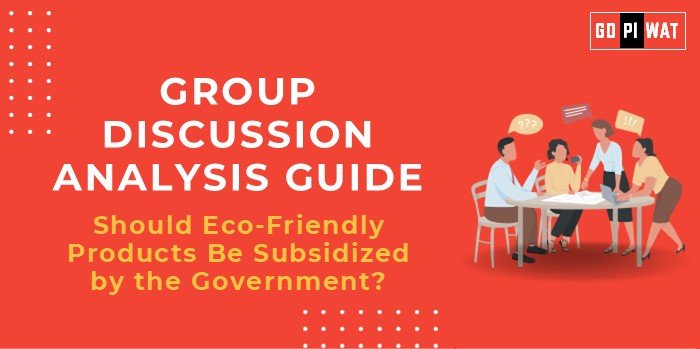📋 Group Discussion Analysis Guide: Should Eco-Friendly Products Be Subsidized by the Government?
🌐 Introduction to the Topic
Eco-friendly products represent a crucial step toward achieving sustainability in consumption and production. Governments worldwide face the challenge of balancing economic growth with environmental protection. Subsidizing eco-friendly products has emerged as a potential solution, spurring debates on its economic viability and effectiveness. This topic is highly relevant to B-school students, as it intersects sustainability, policy-making, and business strategy.
📊 Quick Facts and Key Statistics
- 🌍 Global Market for Green Products: Expected to reach $150 billion by 2030, driven by increased consumer awareness.
- 💨 Carbon Emission Goals: Over 130 countries aim for net-zero emissions by 2050, requiring sustainable practices.
- 🇮🇳 India’s Environmental Initiatives: ₹4,000 crore allocated for green energy in the 2024 budget.
- ♻️ Plastic Waste Generation: India generates 3.5 million tons annually; eco-friendly alternatives can mitigate this issue.
- 🚗 Global Example: Norway’s electric vehicle subsidies led to EVs accounting for over 80% of new car sales in 2023.
🤝 Stakeholders and Their Roles
- 🏛️ Government: Provides subsidies, sets policies, and promotes awareness.
- 🏭 Businesses: Innovate and produce eco-friendly products.
- 🛍️ Consumers: Drive demand through purchase decisions.
- 🌱 Environmental Organizations: Advocate for sustainability and monitor policies.
- 🌐 International Agencies: Offer funding and set benchmarks for green initiatives.
🏆 Achievements and Challenges
✨ Achievements
- ☀️ Adoption of Renewable Energy: Subsidies reduced solar panel costs by over 70% in India in the past decade.
- ♻️ Circular Economy Models: Scandinavian countries lead in adopting subsidized eco-friendly manufacturing.
- 📈 Consumer Awareness: Global campaigns have increased demand for sustainable goods by 30% in the last five years.
⚠️ Challenges
- 💸 High Initial Costs: Subsidizing products often strains national budgets.
- 🌆 Inequitable Distribution: Urban areas benefit more than rural regions.
- ⚠️ Greenwashing Risks: Misleading claims by companies can erode trust.
🌍 Global Comparisons
- 🇳🇴 Norway: High subsidies for EVs have transformed its automotive market.
- 🇺🇸 USA: Federal incentives for solar energy led to a 34% increase in installations since 2020.
📖 Case Studies
- 💡 India’s LED Initiative: Distributed over 360 million subsidized LED bulbs, reducing annual carbon emissions by 28 million tons.
- 🌞 Germany’s Renewable Energy Act: Encouraged decentralized solar power production.
📚 Structured Arguments for Discussion
👍 Supporting Stance:
“Incentivizing eco-friendly products reduces long-term environmental and health costs, proving economically viable.”
👎 Opposing Stance:
“Allocating subsidies to eco-friendly products can divert funds from critical sectors like education and healthcare.”
⚖️ Balanced Perspective:
“A well-designed subsidy program fosters sustainability without overburdening the economy.”
🗣️ Effective Discussion Approaches
🚀 Opening Approaches
- 📊 Statistical Opening: “With a $150 billion market forecast for green products by 2030, incentivizing eco-friendly goods could accelerate sustainability efforts globally.”
- ♻️ Problem-Solution Approach: “Plastic pollution is escalating; subsidizing biodegradable alternatives could be a practical remedy.”
- 📖 Case Study Reference: “Norway’s EV subsidies have demonstrated the transformative potential of government incentives.”
🛠️ Counter-Argument Handling
- 💡 Present alternative funding strategies (e.g., carbon taxes to finance subsidies).
- ✅ Highlight successful examples to counter doubts about efficacy.
📈 Strategic Analysis of Strengths and Weaknesses
- 💡 Strengths: Promotes sustainability, reduces pollution, drives innovation.
- ⚠️ Weaknesses: Risk of misuse, budget constraints, potential market distortion.
- ✨ Opportunities: Boosting exports, creating green jobs, enhancing global leadership.
- ⚡ Threats: Trade-offs with essential services, reliance on subsidies.
🎓 Connecting with B-School Applications
- 📂 Real-World Applications: Policy analysis, green marketing strategies, ESG compliance.
- 🧐 Sample Interview Questions:
- “How should governments prioritize eco-friendly subsidies within budget constraints?”
- “Can subsidies alone drive a green economy transition?”
- 🌟 Insights for Students:
- Develop frameworks for sustainable business models.
- Research global trends in green subsidies.


